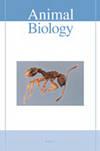Seasonal diets of two rhinolophid bats, Rhinolophus nippon and Rhinolophus cornutus, in the southern Japanese Alps
IF 0.9
4区 生物学
Q2 ZOOLOGY
引用次数: 0
Abstract
Abstract Knowledge of diets is important for understanding species ecology and the mechanism of coexistence of multiple closely related species. Two rhinolophid bats, the greater Japanese horseshoe bat ( Rhinolophus nippon ) and the little Japanese horseshoe bat ( Rhinolophus cornutus ), occur in Japan, but little is known about their diets and interspecific interactions regarding food resources. In this study, we examined the fecal contents of these two species in the Southern Japanese Alps by microscopic analysis over multiple seasons. R. cornutus , which have more skillful flight, consumed nonvolant insects (caterpillars and spiders), whereas R. nippon did not; this indicates that R. cornutus can glean prey better than R. nippon . The larger-bodied R. nippon more frequently consumed hard-bodied beetles, whereas the smaller-bodied R. cornutus more frequently consumed soft-bodied dipterans and neuropterans. Body size differences influenced flight ability and bite force, which resulted in food resource partitioning and enabled multispecies coexistence of these closely related bats. A R. nippon nursery colony consumed a wider variety of insects, such as beetles, moths, and dipterans, during the pregnancy and lactation periods; however, after lactation, they showed a beetle-dependent diet, and before hibernation they again consumed various food resources. A R. cornutus non-nursery colony frequently consumed dipterans and moths in spring; dipterans, moths, and neuropterans in autumn; and moths and neuropterans in winter. These seasonal changes in diet seemed to be related to food supply or reproductive status.两种鼻蝠,日本鼻蝠和角鼻蝠,在日本南部阿尔卑斯的季节性饮食
摘要:了解食性对了解物种生态学和多种近缘物种共存机制具有重要意义。两种鼻蝠,大日本马蹄蝠(Rhinolophus nippon)和小日本马蹄蝠(Rhinolophus cornutus)出现在日本,但对它们的饮食和关于食物资源的种间相互作用知之甚少。在这项研究中,我们通过显微镜分析检查了日本南部阿尔卑斯山脉这两个物种在多个季节的粪便含量。具有更熟练的飞行能力的小角田鼠,会吞食非攻击性昆虫(毛虫和蜘蛛),而日本田鼠则不会;这表明角田鼠比日本田鼠更能收集猎物。体型较大的日本田鼠更频繁地食用硬体甲虫,而体型较小的角田鼠更频繁地食用软体双翅目动物和神经翼目动物。体型差异影响了飞行能力和咬合力,从而导致了食物资源的分配,使这些近亲蝙蝠能够多物种共存。在怀孕和哺乳期间,日本田鼠的苗圃群会吃掉更多种类的昆虫,如甲虫、飞蛾和双翅目昆虫;然而,在哺乳期后,它们表现出依赖甲虫的饮食,在冬眠前,它们再次消耗各种食物资源。在春季,非苗圃群的角田鼠经常捕食双翅虫和飞蛾;秋季的双翅目、蛾类和神经翼目;冬天还有飞蛾和神经翼类动物。这些饮食的季节性变化似乎与食物供应或生殖状况有关。
本文章由计算机程序翻译,如有差异,请以英文原文为准。
求助全文
约1分钟内获得全文
求助全文
来源期刊

Animal Biology
生物-动物学
CiteScore
2.10
自引率
0.00%
发文量
34
审稿时长
3 months
期刊介绍:
Animal Biology publishes high quality papers and focuses on integration of the various disciplines within the broad field of zoology. These disciplines include behaviour, developmental biology, ecology, endocrinology, evolutionary biology, genomics, morphology, neurobiology, physiology, systematics and theoretical biology. Purely descriptive papers will not be considered for publication.
Animal Biology is the official journal of the Royal Dutch Zoological Society since its foundation in 1872. The journal was initially called Archives Néerlandaises de Zoologie, which was changed in 1952 to Netherlands Journal of Zoology, the current name was established in 2003.
 求助内容:
求助内容: 应助结果提醒方式:
应助结果提醒方式:


